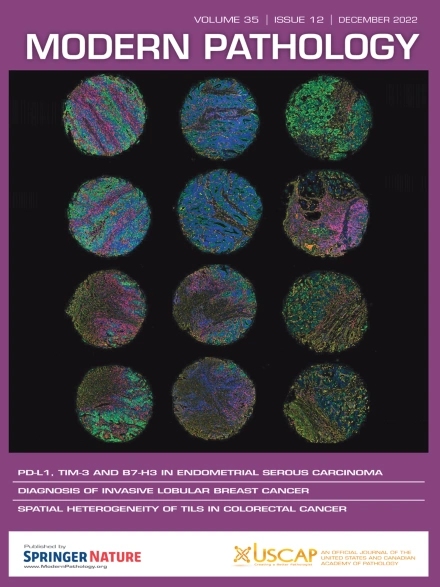快速处理电子显微镜标本可保留诊断性肾活检中肾小球的超微结构和电子致密沉积物:前瞻性与回顾性比较研究
IF 7.1
1区 医学
Q1 PATHOLOGY
引用次数: 0
摘要
随着全球需要用电子显微镜进行准确诊断的肾活检数量不断增加,优化电子显微镜(EM)组织处理方案至关重要。传统的EM处理方法(CEM)是全球95%以上实验室使用的标准方法,至少需要48-52小时才能完成。相比之下,使用微波照射的快速 EM 处理方法(FEM)可在 8 小时内完成,大多数病例可在 24 小时内报告 EM 结果。人们普遍担心 FEM 的质量不佳,可能会影响其诊断作用;然而,支持 FEM 与 CEM 相比无劣势的定性和定量数据尚未见报道。我们进行了前瞻性和回顾性研究。前瞻性分析比较了来自相同活检样本的 FEM 和 CEM 图像。每个病例的组织被分成两块,一块用于 FEM 处理,另一块用于 CEM 处理。这项回顾性研究比较了我们档案中电子致密沉积的肾脏病例的EM图像,这些病例都是通过FEM或CEM处理的。前瞻性分析包括 4 个病例:狼疮膜性肾病、IgA 肾病、免疫复合物介导的肾小球肾炎和急性肾小管损伤。FEM 和 CEM 方法都能获得质量相当的高分辨率图像。对IgA肾病病例的肾小球基底膜(GBM)进行的定量形态分析表明,FEM和CEM处理的GBM厚度相似,这表明FEM不会影响GBM的厚度。对42例电子致密沉积病例的回顾性研究表明,电子致密沉积的超微结构特征在FEM和CEM中无法区分。这包括免疫性肾小球肾炎的微管下结构、冷球蛋白血症肾小球肾炎的 "指纹 "沉积、轻链淀粉样变性和纤维性肾小球肾炎的纤维沉积,沉积物的形态测量结果具有可比性。FEM 高效、一致、可重复,可为肾活检诊断评估提供与 CEM 相媲美的高质量切片和图像,同时大大缩短了周转时间,从而可以提供更快、更准确的诊断结果。本文章由计算机程序翻译,如有差异,请以英文原文为准。
Fast Processing of Electron Microscopic Specimen Preserved Ultrastructure of Glomeruli and Electron-Dense Deposits in Diagnostic Renal Biopsies: A Prospective and Retrospective Comparative Study
Optimization of electron microscopy (EM) tissue processing protocols is essential to handle the global increase in the number of renal biopsies requiring EM for accurate diagnosis. The conventional EM processing method (CEM) is the standard method used by >95% of laboratories worldwide and it takes at least 48 to 52 hours for completion. In contrast, a fast-processing EM (FEM) method using microwave irradiation can be completed in 8 hours, allowing EM findings to be reported within 24 hours for most cases. There is widespread concern about the suboptimal quality of the FEM that may compromise its diagnostic roles; however, qualitative and quantitative data supporting the noninferiority of FEM compared with CEM has not been reported. We performed both prospective and retrospective studies. The prospective analysis compares FEM and CEM images from the same biopsy samples. For each case, the tissue was divided into 2 pieces: 1 piece for FEM processing and the second for CEM processing. The retrospective study compares the EM images of renal cases with electron-dense deposits from our archives that were processed either by FEM or CEM. The prospective analysis included 4 cases: lupus membranous nephropathy, IgA nephropathy, immune complex–mediated glomerulonephritis, and acute tubular injury. Both FEM and CEM methods obtained high-resolution images with comparable quality. A quantitative morphometric analysis of the glomerular basement membrane (GBM) in the IgA nephropathy case showed similar GBM thickness when processed by the FEM and the CEM, suggesting that FEM did not affect GBM thickness. The retrospective study of 42 cases with electron-dense deposits showed that the ultrastructural features of electron-dense deposits were indistinguishable between the FEM and the CEM. This included microtubular substructures in immunotactoid glomerulonephritis, the "fingerprint" deposits in cryoglobulinemic glomerulonephritis, fibril deposits in the light chain amyloidosis as well as fibrillary glomerulonephritis, with comparable morphometric measurements of the deposits. The FEM is efficient, consistent, reproducible, and delivers comparable high-quality sections and images for diagnostic assessment of renal biopsies, compared with those attained by the CEM while decreasing turnaround time significantly, making it possible to provide faster and accurate diagnostic results.
求助全文
通过发布文献求助,成功后即可免费获取论文全文。
去求助
来源期刊

Modern Pathology
医学-病理学
CiteScore
14.30
自引率
2.70%
发文量
174
审稿时长
18 days
期刊介绍:
Modern Pathology, an international journal under the ownership of The United States & Canadian Academy of Pathology (USCAP), serves as an authoritative platform for publishing top-tier clinical and translational research studies in pathology.
Original manuscripts are the primary focus of Modern Pathology, complemented by impactful editorials, reviews, and practice guidelines covering all facets of precision diagnostics in human pathology. The journal's scope includes advancements in molecular diagnostics and genomic classifications of diseases, breakthroughs in immune-oncology, computational science, applied bioinformatics, and digital pathology.
 求助内容:
求助内容: 应助结果提醒方式:
应助结果提醒方式:


